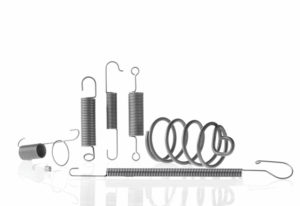
How is a extension spring manufactured, what influence do extension spring designs, loop shapes, spring characteristics and spring materials have, and what do technical terms such as preload, relaxation, yield strength and dynamic loading mean for a tension spring? In order to refresh the basic knowledge for the next tension spring design (video), Gutekunst Federn briefly discusses these topics relating to tension springs. This is because tension springs are indispensable wherever forces have to be applied in tension rather than in compression. Tension springs are used, for example, in vehicle construction as return springs, as well as in garage doors, locks, bed boxes and in relays in plant and equipment construction. Sometimes extension spring systems with several tension springs are also used. The most common application examples are garage door spring assemblies or folding mechanisms for bedside cabinets in parallel connection, where components with larger masses are held in position with constant forces and spring torques.
The production
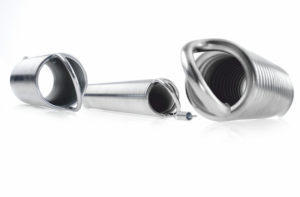
Tension springs are made of round or oval spring steel wires. The spring steel wire is usually cold-formed into any desired shape, either by coiling around a mandrel using a single-finger system or – in the case of fully automatic spring coiling machines – with the aid of several wire guide pins (two-finger or three-finger system). In this process, the eyelets are either formed directly during winching or erected in a downstream operation. Tension springs are usually manufactured cylindrically with a 1/1 German eyelet on each side in accordance with the EN 13906-2 standard. The spring specialist Gutekunst has put together a short video on YouTube showing how a metal spring is manufactured. Just type “spring production video” into Google.
Spring designs and loop shapes
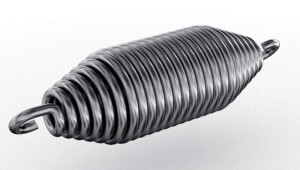
In addition to the cylindrical tension spring design with a linear spring characteristic, tapered or barrel-shaped tension springs are also frequently manufactured. With the conically tapered spring ends, in addition to a progressive spring characteristic, a longer service life is achieved. A degressive force curve cannot be generated via the tension spring design; this requires a tension spring lever mechanism, as with a bed base. Come depending on the application different loop shapes for use. In addition to the classic eyelet shapes such as the 1/1 German eyelet or the hook eye, more resistant spring ends such as the rolled-in threaded bolt or the screw-in threaded plug are also offered, resulting in a longer service life. In general, extension springs are not suitable for fatigue use due to the eyelets, as the eyelet connection at the transition bend is a major weak point.
Three forces occur in tension spring lugs – tensile load, torsional load and bending load. That is why it should be ensured with tension springs that the force acts centrally on the loops, otherwise the risk of an loop breakage increases. In addition, the transition radius (r) from the spring body to the spring eyelet must always be greater than the wire thickness (d).
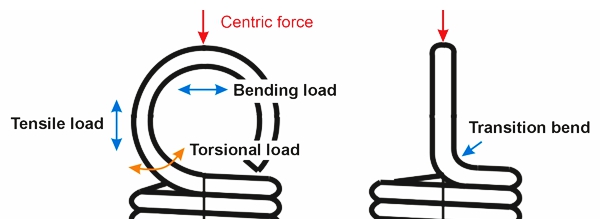
preload
In the case of the extension spring, a twist against the next turn creates a prestress during manufacture. This bias is largely desired because it minimizes the required operating length of the extension spring. However, the following applies to tension spring production: the higher the preload, the higher the production effort. The preload also depends on the winding ratio “w = D/d” (“D” mean winding diameter, “d” wire thickness), it decreases with increasing winding ratio. If no preload is desired for a tension spring, such as a range spring, it can be removed almost completely afterwards by using a higher tempering temperature and longer tempering time. Thermoformed extension springs do not contain any preload either. In order to be able to guarantee the required spring properties, such as structural dimensionality or force properties, after manufacture, the preload (F0) or the mean coil diameter (D) is normally toleranced as production compensation.
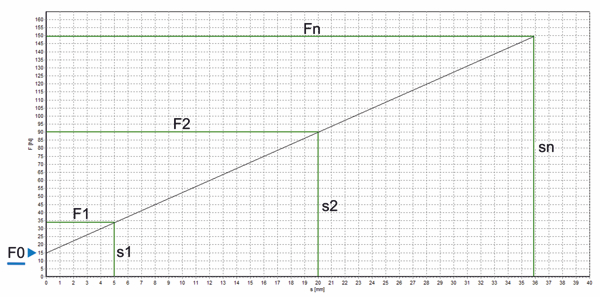
Relaxation, shear stress and spring forces
If the tension spring is loaded at higher temperatures over a longer period of time, a certain percentage of the spring force is lost – as is the case with all metal springs. This loss of strength is called relaxation , and it increases with increasing temperature and voltage. Since relaxation can mean a loss of force of up to 20 percent, depending on the material and temperature, the maximum spring travel should not exceed 80 percent of the permissible stress. If, when the tension spring is loaded, the shear stress exceeds the permissible value of the yield point, a permanent reduction in preload or deformation of the tension spring occurs. Furthermore, attention should be paid to the resonant oscillation of the tension spring; ideally, the oscillations of the excitation frequency are ten times smaller than the natural frequency of the spring, otherwise significant stress increases may occur, leading to spring fracture.
The spring force / spring stiffness depends on the spring steel wire and the spring rate or. spring constant from. The spring rate also defines the ratio of spring force to spring travel. Basically, the dimensioning of the spring force can be influenced by the following measures:
- Wire diameter (d) greater > spring harder
- Outer coil diameter (De) > greater spring softer
- Number of spring coils (n) > greater spring softer
Dynamic load
Dynamic loads are time-varying loads with more than 10,000 strokes. Unlike compression springs, there are no fatigue strength diagrams for extension springs, with which a possible dynamic stress field is specified on the basis of the material, the wire diameter and the stroke tension. The reason for this is the variety of eyelet shapes, most of which do not have fatigue strength due to the transition arc from the spring body to the eyelet. Eyelet forms such as the screwed-in threaded plug or the rolled-in threaded bolt have better dynamic properties, but nevertheless real life tests must be carried out for each dynamically applied tension spring for the respective working application.
Spring material and surface
The selection of the spring steel wire not only influences the spring force, but also provides the appropriate properties for the particular spring application. Thus, in addition to normal unalloyed spring steel wires, stainless spring steels, SiCr-alloyed valve spring wires, copper alloys for good electrical properties, nickel alloys for high heat and corrosion resistance, and titanium alloys for the highest demands from aerospace technology are also used. In addition, various surface treatments can also be applied to optimize the spring. However, with the extension springs, surface treatment is difficult because the coils are so close together.
After and advantages
The disadvantages of the tension spring are the size of the installation space, the sensitive point at the eyelet connection and the resulting total loss of spring force after an eyelet break. The most important advantages of the tension spring are the freedom from kinking, the possibility of centric force transmission and the freedom from friction due to the elimination of guide elements such as sleeves or mandrels.
For further information on the subject of tension springs, please click on the following links or call (+49) 035877 227-11. Good luck!
For more information:
- Design tension springs (video)